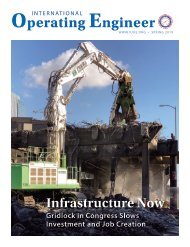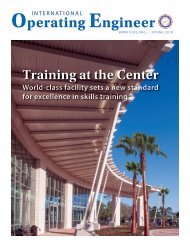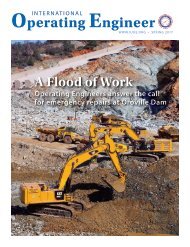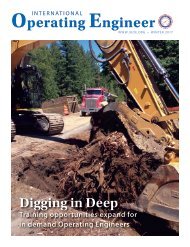International Operating Engineer - Fall 2015
The quarterly magazine of the International Union of Operating Engineers.
The quarterly magazine of the International Union of Operating Engineers.
Create successful ePaper yourself
Turn your PDF publications into a flip-book with our unique Google optimized e-Paper software.
Politics & Legislation<br />
Legislative Action to Battle California Drought Puts<br />
<strong>Operating</strong> <strong>Engineer</strong>s on the Front Lines<br />
OVER THE PAST four years,<br />
California has experienced one of<br />
the worst droughts in state history.<br />
Reservoirs across the state are severely<br />
depleted, holding only 54% of their<br />
historical average. The Sierra Nevada<br />
snowpack contains just 5% of the<br />
normal water content, obliterating<br />
the previous record low of 25% water<br />
content. Snowpack is critical because<br />
when it melts, it refills the reservoirs<br />
during the hot summer months.<br />
According to the California Climate<br />
Tracker, <strong>2015</strong> saw the highest average<br />
temperatures in 120 years of recordkeeping.<br />
These warmer temperatures<br />
have only intensified the effects of the<br />
drought and led to the most destructive<br />
wildfires in California history, burning<br />
over 800,000 acres this calendar year.<br />
Researchers have estimated that the<br />
total drought related economic loss to<br />
state agriculture is about $2.7 billion.<br />
Governor Jerry Brown’s<br />
administration has worked closely<br />
with the state legislature to implement<br />
new regulations and pass legislation<br />
to deal with the drought. Several of<br />
these proposals invest heavily in water<br />
related infrastructure projects and will<br />
require thousands of skilled <strong>Operating</strong><br />
<strong>Engineer</strong>s to complete the work.<br />
• The state has committed more<br />
than $870 million in drought relief<br />
since last year to assist droughtaffected<br />
communities and provide<br />
funding to better utilize local water<br />
supplies.<br />
• Senate Bills 103 and 104 provide<br />
$687.4 million to support drought<br />
relief. The legislation includes<br />
$549 million from the accelerated<br />
expenditure of voter-approved<br />
bonds, Proposition 84 and<br />
Proposition 1E, in the form of<br />
infrastructure grants for local and<br />
regional projects that are already<br />
planned or partially completed.<br />
• Assembly Bills 91 and 92 fasttracked<br />
more than $1 billion in<br />
funding for drought relief and<br />
critical water infrastructure<br />
projects (e.g. water recycling<br />
and infrastructure and flood<br />
protection).<br />
• Proposition 1, California’s $7.5<br />
billion water bond: includes<br />
funding for surface and<br />
groundwater storage, ecosystem<br />
and watershed protections and<br />
restoration, and drinking water<br />
protection.<br />
• The Bay Delta Conservation Plan,<br />
which the Governor introduced<br />
and is currently pending, is a<br />
five-year project that would fix<br />
California’s primary water delivery<br />
system at an estimated cost of $14.9<br />
Emergency drought barrier construction nears completion on<br />
West False River in the Sacramento-San Joaquin Delta.<br />
[photo] CA Department of Water Resources<br />
EnginEErs Action rEsponsE nEtwork<br />
Because elections matter<br />
Make your voice heard • Register for EARN today<br />
www.iuoe.org<br />
billion. This project alone would<br />
create over 40,000 construction<br />
jobs.<br />
Governor Brown was also successful<br />
in securing nearly $20 million in<br />
federal drought relief for California’s<br />
Central Valley Project through the U.S.<br />
Department of the Interior.<br />
To combat the drought at the<br />
federal level, California Senators Diane<br />
Feinstein (D) and Barbara Boxer (D),<br />
introduced The California Emergency<br />
Drought Relief Act (S.1894). Some of<br />
the key elements of this legislation are:<br />
• The RIFIA loan program:<br />
Authorizes $200 million for<br />
the Reclamation Infrastructure<br />
Finance and Innovation Act<br />
(RIFIA). This loan-guarantee<br />
program will allow water districts<br />
and municipalities to leverage<br />
loans and loan guarantees<br />
for water projects, reducing<br />
repayment loan costs by as much<br />
as 25 percent. This is modeled after<br />
TIFIA, a successful loan-guarantee<br />
program for transportation<br />
projects.<br />
• WaterSMART grant improvements:<br />
Authorizes $100 million in<br />
increased funds for the Bureau<br />
of Reclamation’s WaterSMART<br />
program to help finance water<br />
reclamation and reuse projects as<br />
well as water efficiency initiatives.<br />
• Title XVI water recycling program<br />
reforms: Authorizes $200 million<br />
in increased funds for the Bureau<br />
of Reclamation’s water recycling<br />
and reuse program (Title XVI) to<br />
help fund projects to reclaim and<br />
reuse wastewaters and naturally<br />
impaired ground and surface<br />
water.<br />
This legislation is currently being<br />
considered at the Senate Energy and<br />
Natural Resources Committee, chaired<br />
by Alaskan Senator Lisa Murkowski.<br />
In the U.S. House of Representatives,<br />
California Congressman David<br />
Valadao (R-21) introduced the Western<br />
Water and American Food Security Act<br />
of <strong>2015</strong> (H.R. 2898). This legislation<br />
passed the House on July 16th by a vote<br />
of 245 – 176, and is also currently being<br />
considered in the Senate Energy and<br />
Natural Resources Committee.<br />
Congressman Jared Huffman,<br />
representing California’s second<br />
congressional district, has also<br />
introduced legislation - H.R. 2983,<br />
Drought Recovery and Resilience Act<br />
of <strong>2015</strong>. This bill has not yet been voted<br />
out of committee.<br />
These various state and federal<br />
initiatives will create tens of thousands<br />
of construction jobs and the <strong>Operating</strong><br />
<strong>Engineer</strong>s will be on the front lines<br />
building these water infrastructure<br />
projects and playing a vital role in<br />
helping Californians survive this and<br />
future droughts.<br />
10<br />
INTERNATIONAL OPERATING ENGINEER<br />
FALL <strong>2015</strong> 11

















